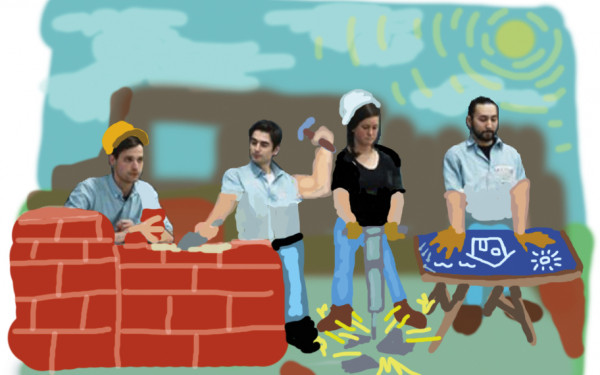Sprouting Green Thumbs on Campus
Greenhouses Provide Students with a Year-Round Urban Refuge
Having green, student-run urban oases year-round has both direct and indirect benefits for students, and we need to encourage student initiatives looking to create new sustainable spaces on campus.
Greenhouses are a source of sunlight in the winter and an opportunity to share research and knowledge, in addition to contributing to urban agriculture and providing a connection to growing plants.
The Concordia University campus is currently home to two greenhouses and there are plans for a third. One of the greenhouses is found at the Loyola campus in the Science Pavilion; not open to the public, it’s mainly used for research by the biology department. The more popular of the two is therefore the publicly-accessible Concordia Greenhouse, a student-run fee-levy group found on the 13th floor of the Hall Building downtown.
If you haven’t been there yet, you’re missing out. Step into the greenhouse atrium and experience fresh air, sunlight and a great community. The space is key to surviving the cold winter months.
“So many people talk about—especially students that are not used to Montreal winters—how it helps them get through the winter to be in a space that is warm and sunny and full of plants,” said Jackie Martin, the coordinator of the Concordia Greenhouse’s City Farm School.
“People make connections and meet each other and maybe get involved in projects that way.”
The greenhouse grows microgreens and supplies them to many on-campus organizations, such as Le Frigo Vert, the Hive Café Solidarity Cooperative, the Concordia farmers’ market and other conscientious organizations like Burritoville.
“Since the greenhouse is a controlled environment and it’s an environment that can be used to grow all year round, it has the potential to expose people to growing and to plants and to techniques,” said Stephanie Dimitrovas, coordinator of the greenhouse’s Four Seasons Growing Project.
“However, what we need to keep in mind is that it is a simulated environment so there are a lot of things we need to stimulate. For example, in the winter, we do need heat and supplemental lighting.”
Dimitrovas added that Concordia Greenhouse will soon purchase supplemental lighting with the funds they received from the Concordia Council on Student Life. The greenhouse does not have the latest, most cutting-edge technologies, but maintenance and small adjustments like additional lighting can help to deal with increasing demand for its produce.
Collège Ahuntsic, a CEGEP in the north end of Montreal, has recently upgraded to an automatic greenhouse that is more energy efficient and increases growing capacity. It’s one of the newest greenhouses in an institutional setting in Montreal.
“We didn’t have what we needed to reconstruct [the old greenhouse], but we had to demolish it because it had become a problem,” said Michel Poncelet, the director of equipment services at the CEGEP. “At some point we got the necessary funding to build the one we currently have.”
_900_443_90.jpg)
Why plan for another new greenhouse at Concordia when we seem to have one that provides so much already? Not only would another student-run greenhouse allow for more initiatives, it would also provide for more local, student-run food options on campus.
“I’m excited personally because it means more growing,” said Dimitrovas.
A new greenhouse could address the limitations of the greenhouse atop the Hall Building, providing more space and making use of newer technologies.
Concordia students have previously demonstrated strong support for student-run and sustainable food options on campus during Concordia Student Union elections, so more urban agriculture projects are likely right around the corner.
Since the Concordia Greenhouse focuses on urban sustainability and community building and raising awareness of the issues surrounding food security, the new greenhouse would focus on food production and urban agriculture.
Summer is the best growing season in Montreal and, to maximize growth production, seedlings can be started in greenhouses.
“The more greenhouses we have, the more seedlings we can produce at low cost for gardens all over the city,” Martin said.
Last year, Vert Ta Ville sold $8,000 worth of seedlings, or roughly 3,000 plants, which went out to 14 organizations and many other urban gardeners who normally would not have access to seedlings at the price they are offered.
Concordia, especially through student initiatives, has been expanding and building a potentially exemplary sustainable food system.
From production to distribution and waste management, we can alleviate the stresses transportation and mass food production have on the environment by internalizing and hyper-localizing the process.
Greenhouses allow students to feel a connection to their food and give them the opportunity to learn how to grow in an urban setting, to share knowledge and to experience local organic produce at an affordable price.
This is the system we must continue to germinate on campus.
Jessica Cabana is the Concordia Student Union’s VP Sustainability.
This article originally appeared in Volume 35, Issue 13, published November 18, 2014.

_900_597_90.jpg)


2_600_375_90_s_c1.jpg)
1_copy_600_375_90_s_c1.jpg)
2_600_375_90_s_c1.jpg)